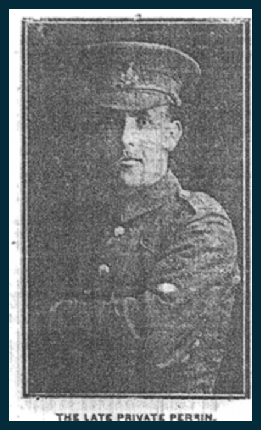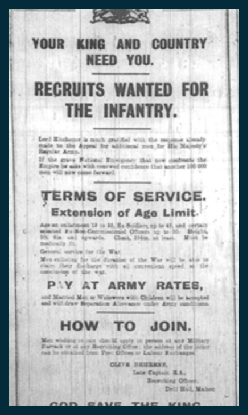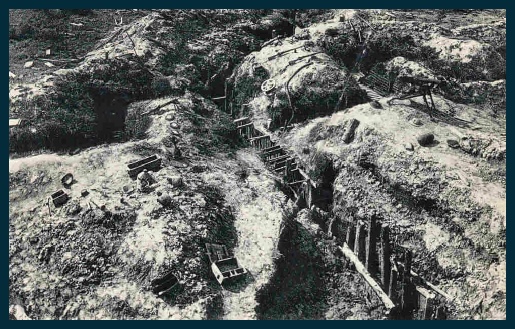Copyright © All rights reserved.



Harry Perrin

‘As they tramped along the pave road, … the boom of guns became even louder. Crowds of refugees were met, hurrying westwards with handcarts perambulators and almost any kind of vehicle laden with all the worldly possessions left to them’ They learnt that they
were to be held in Corps Reserve and ready to move at ten minutes’ notice and next morning proceeded [less Machine Guns] to the banks of the Yser Canal in support of 2nd Zouaves.
The Battalion lined the Canal banks under the shelter of a ridge before daylight, the men shortly afterwards digging themselves into shelter holes. Here they had their first experience of shell fire in forenoon, but sustained no injury.
Shortly in the afternoon the Battalion was ordered to cross the Canal and proceed to Saint Jean to the support of the 3rd Canadian Infantry Brigade. This village was soon afterwards in flames and the Battalion skirting its rear, skirmished across open country under heavy shelling to the 3rd Canadian Infantry Brigade HQ.
The next day at 3.00 am they received orders to proceed to Fortuin. En route they passed a number of detached bodies of troops in retreat. They arrived at the rendezvous about 5.00 am and with daylight shelling commenced. B and C Companies occupied line of reserve trenches, but no shelter was available for the A and D Companies except the hedge bottom on roadside. About 6.00 am these latter Companies advanced to support of Royal Irish across open field and were met with heavy shrapnel fire. When the order was given to retire A and D Companies suffered severely, losing 8 killed and about 40 wounded. They then dug themselves in the hedge bottom of a field to the left of the road and alternating bursts of the shell and rifle fire continued throughout the day.
Captain Purvis reported small parties of Germans due North in the trenches. Orderlies were sent to Brigade stating that "Enemy was inclined to press" and asking "Have you any orders?" No reply could be obtained. Other casualties occurred from shell and rifle fire, which died down at nightfall, when the dead were collected and buried. The wounded had all been attended to under fire and conveyed to the advanced dressing station.
The next day the position was unchanged. Again they reported their positon to Brigade and again were ordered to remain. Heavy shelling continued as on previous day with considerable sniping and a closely adjacent farmhouse was destroyed by enemy's incendiary shells. They were finally relieved two days later, having lost 30 men and with over 100 wounded.
By 4th April they were in billets in Steenwoorde where Field Marshall Sir John French addressed them “I have come here this morning to express to every single Officer and man how much I admire the splendid behaviour of the Battalion in the fighting which has gone on during the last ten days. The 5th Yorkshire Regiment has suffered heavily. You have had one Officer killed, one Officer wounded, twenty eight men killed and one one hundred and five men wounded.
When you came out here you were called upon very hurriedly and you had very little preparation. Things do come that way, very suddenly, in War. The call came through of the disgraceful conduct [gas] of the people who are fighting us, who call themselves soldiers, but who behave in a very unsoldierlike way. In the circumstances we could not wait and had to do the best we could. I do not want to go into details of that fight, because there were other British soldiers engaged. I want particularly to talk of the splendid conduct of the men of the 50th Northumbrian Division, and especially of your Battalion. I wish to compliment every one of you. I am very grateful to you, for all you have done. I think your conduct magnificent.
Whenever I am speaking of Territorial soldiers I find it very difficult adequately to express how strongly I feel on the subject. I had a good deal to do with Territorial soldiers before the War, when I was Inspector General of the Forces, and I have always said that when the Territorial Force was called upon, and put to the test, it would not be found wanting.
A good many of our countrymen did not agree with me. But you have shown right well that not only were you found not wanting, but that you were capable of taking your place and fighting splendidly in accordance with the best traditions of the British Army.
Your conduct has been superb. Nothing is more difficult than to come out in the ordinary way of routine as you did and then suddenly to be called upon to fill a breach that has so suddenly occasioned.
You showed a spirit of splendid patriotism months ago when, leaving your work and homes, you volunteered for foreign service, though originally you had only taken the responsibilities of home defence. This you did in defence of the British Empire, and whilst others remained behind, you have come here to do your duty and have done it and have set a magnificent example.
I am sure that when your fellow countrymen fully realise your magnificent behaviour, they will thank you as I thank you now. I feel confident that you will keep up the splendid record that you have established whenever you are called upon."
According to the obituary published in the Malton Messenger, Harry worked for some time at the Rosedale iron mines – presumably also as a horseman but by 1914 he was evidently back in Malton, living at 5 Soulby’s Yard, though it was in Pickering that he signed up, probably in the first rush of enthusiasm generated when war was declared in 1914, as the Malton Messenger of 5th September lists him among those who had already gone from Malton. He joined the 5th Battalion of the Yorkshire Regiment which was at the start of the war at least, recruited largely from Ryedale and were affectionately known as the Scarborough Terriers.
Through the rest of 1914 and the beginning of 1915 the 5th Battalion underwent training in various areas of the North-
The next day they arrived at Boulogne and left by train at night arriving at Cassels at 6.00 am and then marching twelve ‘hot and very tiring’ miles to billets outside the village of Steenvoorde, where they had finally rested, for three whole days. On the 23rd April they proceeded by Motor Buses to Vlamertinghe and from thence marched to A Huts at Ypres.
Harry Perrin was born in the third quarter of 1892 and his birth was registered in Malton. He was the eldest son of Reginald Henry and Charlotte Ann (nee Warcup) Perrin who married in the Malton area in the third quarter of 1890. In 1891 Reginald and Charlotte were living in Albert Place on Hope Street (now Beverley Road) and presumably this is where their older three children were born, though the HMSO list of soldiers who died in the Great War gives his birthplace as Whitewall, which is presumably where Reginald was working as a groom.
They seem to have moved to Malton about 1899 and by 1901 were living at 3 Green Man Yard, Malton, where a further three children were born.
1901 Census – resident at 3 Green Man Yard, Malton
PERRIN, Reginald Henry, Head, Married, M, 32, Groom Domestic, Norton Yorkshire,
PERRIN, Charlotte Ann, Wife, Married, F, 34, , Gricethorpe Yorkshire,
PERRIN, Harry, Son, Single, M, 8, , Norton Yorkshire,
PERRIN, Ada, Daughter, Single, F, 7, , Norton Yorkshire,
PERRIN, Joseph, Son, Single, M, 3, , Norton Yorkshire,
PERRIN, Mary, Daughter, Single, F, 1, , Malton Yorkshire,
Reginald died in the first quarter of 1906 and in 1911 Charlotte was living with Ada and the three youngest children at 182 Soulby's Yard Greengate and Harry and Joe were both working
as horsemen in Thixendale.
1911 Census – resident at Manor Farm, Thixendale
COOK, Edward John, Head, Single, M, 31, Farmer, Yorks Fimber,
ALMOND, Sarah Ann, Servant, Single, F, 39, Working Housekeeper, Hosforth Yorks,
SAWDON, Ada Anne, Servant, Single, F, 20, Servant Domestic, Yorks Thixendale,
STOCKHILL, Laurance Herbert, Servant, Single, M, 20, Horseman On Farm, Settrington Yorks,
FOUND, William, Servant, Single, M, 23, Head Horseman On Farm, Yorks Flixton,
WOOD, Charles, Servant, Single, M, 20, Horseman On Farm, Yorks Thixendale,
PERRIN, Harry, Servant, Single, M, 18, Horseman On Farm, Yorks Malton,
PERRIN, Joe, Servant, Single, M, 14, Horseman On Farm, Yorks Norton,
BRADLEY, Wiliam, Servant, Single, M, 20, Shepherd Helper, Yorks Thixendale,


On 9th April they were back in the trenches and by 18th had moved to Sanctuary Wood. Lt Turnbull wrote of the conditions:
‘We entered the trenches about midnight, we found them very uncomfortable, as there was only one dug-
I spent six hours making myself a shelter in a communication trench, a sort of sofa with a waterproof sheet above it, cut out of one side of a five-
Private Ronald Gough had written home :-
‘Just a few lines to let you know that I am still alive and in the best of health. I am really suffering from overwork, because we have had a good deal to do just recently. One can only thank God for the escapes that one has every day. I am sitting in the trenches writing this, and the birds are all singing, the cuckoo in particular. You would hardly think that such a war was going on, the bullets whizzing over your head, and the shells screaming. We got slightly gassed the other day, it was awful stuff. It makes your eyes ache and gets into the lungs. Some men further up the line were terrible, staggering like drunken men’
On the 2nd June the Battalion returned to a field about half a mile South of Vlamertinghe, where they bivouacked until the 6th when they relieved 1st Northumberland Fusiliers in Sanctuary Wood. On the 12th June 1915 they were relieved by the 7th Durham Light Infantry. In the course of this Harry was killed.
His commanding officer Captain G.J. Scott wrote to Harry’s mother: “Dear Madam, -
Harry is buried in Hooge Crater Cemetery. Hooge Chateau and its stables were the scene of very fierce fighting throughout the First World War. From 24 May to 3 June 1915, the chateau was defended against German attacks and in July 1915, the crater was made by a mine sprung by the 3rd Division. Hooge Crater Cemetery was begun by the 7th Division Burial Officer early in October 1917. It contained originally 76 graves, in Rows A to D of Plot I, but was greatly increased after the Armistice when graves were brought in from the battlefields. According to the Burial Return recording the exhumation and reburial of bodies in the Zillebeeke area, Harry’s body was found in an isolated grave under a cross and was readily identifiable. He was re-
Harry is commemorated on the Rosedale Abbey and Pickering Town War Memorials as well as on the Malton Town Memorial and in St Leonard’s Church.